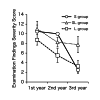The Combined Effects of Sublingual Immunotherapy and Lactobacillus acidophilus-Producing Extract on Cedar Pollinosis Symptoms
- PMID: 37408939
- PMCID: PMC10319452
- DOI: 10.7759/cureus.41374
The Combined Effects of Sublingual Immunotherapy and Lactobacillus acidophilus-Producing Extract on Cedar Pollinosis Symptoms
Abstract
Introduction: Sublingual immunotherapy (SLIT), in which standardized cedar pollen extract solution is administered, has been used to treat cedar pollinosis, but SLIT is problematic because it takes a long time to become effective, and some cases are ineffective even after long-term treatment. It has also been reported that lactobacillus acidophilus extract (LEX), a food-derived ingredient, alleviates various allergic symptoms. This study examined the usefulness of LEX as a treatment for cedar pollinosis in comparison with SLIT. We also examined whether the combined use of SLIT and LEX could have an early-onset of therapeutic effect on cedar pollinosis. We also examined the usefulness of LEX as a salvage therapy for patients who failed to respond to SLIT.
Subjects and methods: Fifteen patients with cedar pollinosis were divided into three groups. The three groups were: three patients in the standardized cedar pollen extract group (S group), seven patients in the lactobacillus-producing extract group (L group), and five patients in the combination group of standardized cedar pollen extract and lactobacillus-producing extract (SL group). The subjects were treated for three years, corresponding to the three scattering seasons of cedar pollen, and observed according to the evaluation items. The evaluation items were severity score based on examination findings, subjective symptom score (QOL score) based on the Japanese Standard QOL Questionnaire for Allergic Rhinitis (JRQLQ No. 1) questionnaire, nonspecific IgE level measurement by blood test, and cedar pollen-specific IgE level measurement.
Results: After three years of observation, there were no significant differences in severity score and nonspecific IgE levels among the three groups, while QOL score decreased significantly between the first and third years of treatment in the L group. Cedar pollen-specific IgE levels in the S and SL groups showed an increase in the first year and a gradual decrease in the second and third years of treatment compared to the pre-treatment period. In group L, no increase was observed in the first year, and a significant decrease was observed in the second and third years during the cedar pollen dispersal period.
Conclusions: The results of severity and quality of life scores indicated that it took three years of treatment for the S and SL groups to show efficacy, while the L group showed improvement in quality of life scores and cedar pollen-specific IgE levels from the first year, suggesting that LEX is useful as a treatment for cedar pollinosis. The efficacy of combination therapy with SLIT and LEX was not clear, but since the effect of LEX was observed from the early stage of treatment, it was thought that the combination therapy with LEX intake from the early stage of treatment may be effective in reducing the incidence of ineffective cases. The combination therapy of SLIT and LEX may also be useful as a salvage therapy.
Keywords: combination effect; fast onset of effects; food ingredients; ineffective cases; japanese cedar pollen; lactobacillus acidophilus produced extract (lex); pollinosis; salvage therapy; seasonal allergic rhinitis; sublingual immunotherapy (slit).
Copyright © 2023, Hirobumi et al.
Conflict of interest statement
The authors have declared that no competing interests exist.
Figures




References
-
- [National epidemiological survey of nasal allergy 2019 (1998, compared with 2008): preliminary report - otolaryngologists and their families] Matubara A, Sakashita M, Goto Y, et al. https://www.jstage.jst.go.jp/article/jibiinkoka/123/6/123_485/_article/-... J Otolaryngol Jpn. 2020;123:485–490.
-
- Sublingual immunotherapy in allergic rhinitis. Han DH, Rhee CS. https://www.ncbi.nlm.nih.gov/pmc/articles/PMC3206241/ Asia Pac Allergy. 2011;1:123–129. - PMC - PubMed
-
- Sublingual immunotherapy for japanese cedar pollinosis: current clinical and research status. Sakurai D, Ishii H, Shimamura A, Watanabe D, Yonaga T, Matsuoka T. https://www.mdpi.com/2076-0817/11/11/1313 Pathogens. 2022;11 - PMC - PubMed
-
- Current status of sublingual immunotherapy for allergic rhinitis in Japan. Masuyama K, Matsuoka T, Kamijo A. https://doi.org/10.1016/j.autneu.2007.08.002. Allergol Int. 2018;67:320–325. - PubMed
-
- [Studies on immunomodulatory effects of lactic acid bacteria] Sasihara N. https://www.jstage.jst.go.jp/article/jim/27/4/27_197/_article/-char/ja/ J Enterobacteriol. 2013;27:197–202.
LinkOut - more resources
Full Text Sources
